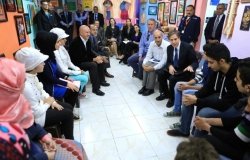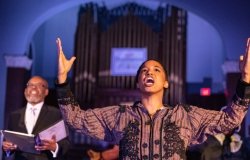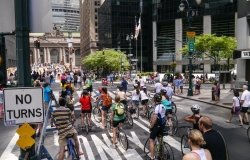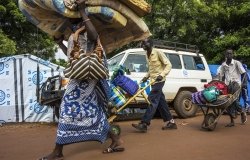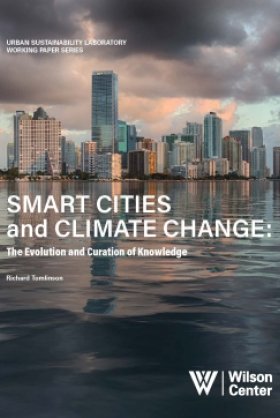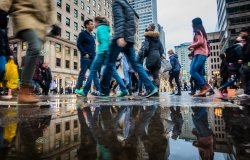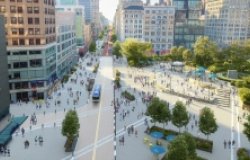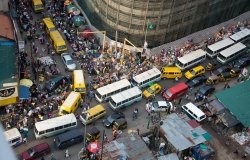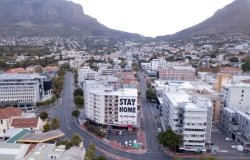Concepts of Immigration and Integration in Urban Areas
Overview
Despite attempts to control the inflow of migrants, millions of people make their way to cities every year. Historically, immigrants have settled in urban areas, seeking to capitalize on the economic opportunities cities offer. On April 30, the Comparative Urban Studies Project sponsored a seminar, Concepts of Immigration and Integration in Urban Areas. Panelists Caroline Brettell, Southern Methodist University and Mamadou Diouf, University of Michigan examined the urban policies, spatial patterns, and attitudes that influence and shape the role migrants play in the Dallas Fort Worth Metroplex and Senegal.
Dr. Caroline Brettell began by outlining various spatial trends in immigrant settlement. Describing earlier fieldwork among Portuguese immigrants in Toronto and Paris, she discussed how both state policy and the state-specific historical trends in immigrant settlement led to more concentrated areas of Portuguese households in Toronto and more dispersed patterns of residence in Paris. From this example, she detailed her work among various immigrant groups in the Dallas Fort Worth Metroplex, which is widely recognized as a "gateway city" for many immigrants. After examining the county wide urban patterns of settlement of Indians, Vietnamese, Mexicans, Salvadorians, and Nigerians, it became clear that while many immigrant groups were attracted to residential areas by a critical mass of others, other groups moved directly into the suburbs or nearer to their place of employment. Besides the presence of other members of a cultural group, employment, land scarcity, and other factors impact the settlement choices of immigrants. This underlines the important role of cultural centers, where new immigrants can meet others from a similar cultural background and buy culture-specific products, in the maintenance of cultural identity. Immigrants settling in the suburbs sometimes live away from these centers, but regard them as the core of the ethnic and cultural community. Dr. Brettell described the changing landscape of the Dallas Fort Worth area, with immigrant groups of all sorts constructing cultural centers, churches, temples, and mosques. Some buildings are located within neighborhoods dominated by ethnic and cultural groups, while others, due to land scarcity, are located further away. Dr. Brettell also highlighted the importance of cultural festivals, such as celebrations of national independence, for the continued maintenance of cultural identity. As is evident, immigrants influence the culture of cities and are influenced by it.
Mamadou Diouf discussed the colonial aspects of the African city, examining whether cities are European or African, and how this has influenced urban settlement in Senegal. From the beginning the colonists participated in deterritorialization, spreading characterizations of Africans as peasants in villages, a discourse which led to the widespread belief among Africans that cities were dangerous places where Africans lose their souls. African actors currently manipulate urban legends and practices to try to reclaim cities as rightful places of habitation, but these discourses are themselves constructed through transactions among different groups. The two main groups are the originaire, those Senegalese who received French citizenship during the French Revolution, their descendents, and most Western-educated Senegalese, and the mourid, a religious brotherhood of groundnut producers who were not interested in citizenship or Western education. While the urban originaire interacted with the colonists, paid taxes, had legal status as property owners, and engaged in political and cultural transactions to obtain their own urban space (for example, constructing mosques that looked identical to churches, but substituting minarets for crosses), the mourid were not present in cities until the economic collapse of the 1970s. After they arrived in cities, whether in Senegal or abroad, the mourid domesticated new spaces and created alternative spaces. They call all of their settlements in new lands Touba City, after their original sacred city in Senegal. These new settlements, whether in New York or Italy are recreations of the ritual community present in Touba. Today, mourid immigrants send large amounts of remittances to Touba, to maintain ties and reinvest in this community. Additionally, the mourid always return to Touba to be buried. Touba, the second largest city in Senegal, is administered more like a village than a metropolis. The mourid use their own linguistic accent to distinguish themselves from others, and resist global ideas including the Arabic interpretation of Islam, preferring their own version. Dr. Diouf indicated that the mourid rejection of integration calls for newer understandings of modernity, and the acceptance of alternative models, including those, which reject the ideology of development and modernization.
Blair Ruble closed the session, commenting on the similarities between the experience of the Dallas Fort Worth Metroplex immigrants and the mourid immigrants and the creation of new Touba Cities within host countries. Both the suburbs of the Metroplex and Touba City can exist everywhere and nowhere at once. They reflect the process of political, cultural, and economic negotiation between different cultural groups. These processes establish the grounds for identity and possibilities for integration, but are also characterized by contestation.
Hosted By

Urban Sustainability Laboratory
Since 1991, the Urban Sustainability Laboratory has advanced solutions to urban challenges—such as poverty, exclusion, insecurity, and environmental degradation—by promoting evidence-based research to support sustainable, equitable and peaceful cities. Read more
Thank you for your interest in this event. Please send any feedback or questions to our Events staff.
